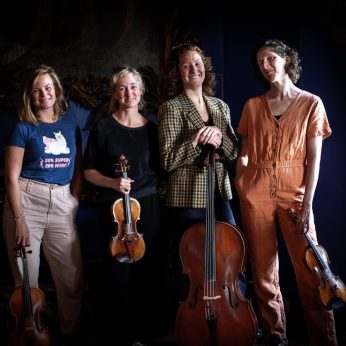Composer: Wolfgang Amadeus Mozart (b. 1756 - d. 1791)
Performance date: 25/06/2023
Venue: Bantry House
Composition Year: 1782
Duration: 00:30:31
Recording Engineer: Tom Norton, RTÉ
Instrumentation: 2vn, va, vc
Instrumentation Category:String Quartet
Artists:
Ragazze Quartet (Rosa Arnold, Jeanita Vriens [violins] Annemijn Bergkotte [viola], Rebecca Wise [cello]) -
[String Quartet]

Quartet in G major K.387 [1782]
1. Allegro vivace assai
2. Menuetto. Allegro
3. Andante cantabile
4. Molto Allegro
This Quartet is the first in the famous series of six that were dedicated to his friend and mentor, Joseph Haydn. It was completed on the last day of 1782. The last in the series, the Dissonance, was not signed off until January 1785. There is no doubt that Mozart was inspired to compose these six glorious quartets as a response to Haydn’s six Russian Quartets Op.33, which had been published in Spring 1782. We stand here at the earliest days of the fantastic flowering of the Golden Age of the string quartet in the fifty-five years from Haydn’s Sun Quartets of 1772 to Beethoven’s last Quartet in 1826.
Haydn provided the formal, intellectual foundation for the string quartet, once described as the expedient application of reason and witty dialogue. Mozart’s language is that of a born music dramatist and the expression of human passions. The dramatic genius of the great opera composer can be heard in the humble string quartet. This is especially the case in the G major Quartet we hear this evening.
In preparation for writing these new quartets, Mozart undertook intensive studies of the fugues by the Bach family, Wilhelm Friedemann’s and Johann Christian’s as well as Johann Sebastian’s. He discovered their work in the library of his friend and patron, Baron von Swieten, who hosted private concerts of Bach’s and Handel’s music every Sunday at noon. These studies bore fruit in the many fugues that Mozart composed and arranged in this period, but with none of them quite so superbly outrageous as the Finale of this Quartet.
The key of G major turns out to lead to some rough dissonances and fairly gritty music, despite the surface polish. The opening subject has a sinuous line that readily lends itself to chromatic and contrapuntal development. Indeed the extended development section is almost entirely concerned with the possibilities this theme offers. The second subject has two sections, both bright and airy and full of brilliant dynamic contrasts. It ends with a cadence that serves as a form of punctuation throughout the development and the lengthy recapitulation and indeed has the last word in the coda.
One feature of Haydn’s Russian Quartets was the increasing complexity of his Minuets, which he renamed Scherzos (Hans Keller calls them anti-minuets). He did this by calling into question the basic dance structure of the minuet. Mozart follows Haydn’s example by distorting the dance character of this minuet, the 3/4 beat keeps jumping the rails in increasingly eccentric ways. This fascinating exercise greatly extends the scope of this movement, without in any way compromising its charm. The Trio announces itself with intrusive G minor chords, which crush every attempt to create delicate threads of melody. The return of the minuet is a relief after this threatening atmosphere.
The Andante cantabile is another fantastic harmonic journey like the first movement. The richly decorated theme is seduced into travelling to the most obscure and faraway tonalities before returning to more familiar regions. This is a wonderfully spacious movement, the emotional heart and expressive climax of the quartet. The Finale is Mozart showing off his mastery of the deadly serious business of composing fugues by using themes straight out of opera buffa, the archaic notion of the fugue is made to turn somersaults with themes that could have come straight out the Seraglio. So the sober four notes contour of the initial fugal theme quickly turns acrobatic when juxtaposed with the joyful counter-themes. This brilliant high-wire act of Mozart bringing together all his learning in a high-spirited finale is the ideally effervescent conclusion to this remarkable work.
Francis Humphrys
Copyright © 2025 West Cork Music. All rights reserved.
Designed and developed by Matrix Internet